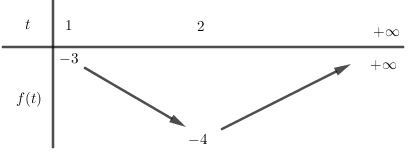Hãy nhập câu hỏi của bạn vào đây, nếu là tài khoản VIP, bạn sẽ được ưu tiên trả lời.

ĐK: \(-2\le x\le2\)
Đặt \(\sqrt{x+2}+\sqrt{2-x}=t\left(2\le t\le2\sqrt{2}\right)\)
Phương trình đã cho trở thành:
\(t+t^2-4+2m+3=0\)
\(\Leftrightarrow2m=f\left(t\right)=-t^2-t+1\)
Phương trình đã cho có nghiệm khi \(minf\left(t\right)\le2m\le maxf\left(t\right)\)
\(\Leftrightarrow-7-2\sqrt{2}\le2m\le-5\)
\(\Leftrightarrow\dfrac{-7-2\sqrt{2}}{2}\le m\le-\dfrac{5}{2}\)

ĐKXĐ: \(-2\le x\le2\)
Đặt \(\sqrt{x+2}+\sqrt{2-x}=t\Rightarrow\left\{{}\begin{matrix}2\le t\le2\sqrt{2}\\2\sqrt{-x^2+4}=t^2-4\end{matrix}\right.\)
Pt trở thành:
\(t+t^2-4+2m+3=0\)
\(\Leftrightarrow t^2+t-1=-2m\)
Xét hàm \(f\left(t\right)=t^2+t-1\) trên \(\left[2;2\sqrt{2}\right]\)
\(-\dfrac{b}{2a}=-\dfrac{1}{2}\notin\left[2;2\sqrt{2}\right]\)
\(f\left(2\right)=5\) ; \(f\left(2\sqrt{2}\right)=7+2\sqrt{2}\)
\(\Rightarrow5\le-2m\le7+2\sqrt[]{2}\)
\(\Rightarrow-\dfrac{7+2\sqrt{2}}{2}\le m\le-\dfrac{5}{2}\)
Có đúng 1 giá trị nguyên của m thỏa mãn là \(m=-4\)

Điều kiện xác định x∈Rx∈R.
Đặt t=√x2+1 (t≥1t≥1)
Phương trình trở thành t2−1−4t−m+1=0
⇔t2−4t=m
⇔t2−4t=m. (1)
Để phương trình có 44 nghiệm phân biệt thì phương trình (1) có hai nghiệm phân biệt lớn hơn 11.
Xét hàm số f(t)=t2−4t có đồ thị là parabol có hoành độ đỉnh x=2∈(1;+∞) nên ta có bảng biến thiên:
Dựa BBT ta thấy để (1) có hai nghiệm phân biệt lớn hơn 11 thì −4<m<−3
Vậy không có giá trị nguyên của mm thỏa mãn yêu cầu bài toán.

Đặt \(\sqrt{x-1}+\sqrt{5-x}=t\)
\(t\ge\sqrt{x-1+5-x}=2\)
\(t\le\sqrt{2\left(x-1+5-x\right)}=2\sqrt{2}\)
\(t^2=4+2\sqrt{\left(x-1\right)\left(5-x\right)}\Rightarrow\sqrt{\left(x-1\right)\left(5-x\right)}=\dfrac{t^2-4}{2}\)
Pt trở thành:
\(t+\dfrac{3\left(t^2-4\right)}{2}=m\Leftrightarrow\dfrac{3}{2}t^2+t-6=m\)
Xét hàm \(f\left(t\right)=\dfrac{3}{2}t^2+t-6\) với \(t\in\left[2;2\sqrt{2}\right]\)
\(-\dfrac{b}{2a}=-\dfrac{1}{3}\notin\left[2;2\sqrt{2}\right]\)
\(f\left(2\right)=2\) ; \(f\left(2\sqrt{2}\right)=6+2\sqrt{2}\) \(\Rightarrow2\le f\left(t\right)\le6+2\sqrt{2}\)
\(\Rightarrow\) Pt có nghiệm khi \(2\le m\le6+2\sqrt{2}\)

TXĐ: D=\(\left[-2;2\right]\)
Đặt \(\sqrt{x+2}+\sqrt{2-x}=a\ge0\Rightarrow a^2=4+2\sqrt{-x^2+4}\)
Khi đó: pt trở thành: \(a+a^2+2m-1=0\) (*)
để pt đã cho có nghiệm thì pt(*) có nghiệm
khi đó \(\Delta=1^2-4\left(2m-1\right)=-8m+2\ge0\Rightarrow m\le\dfrac{1}{4}\)
???

ĐKXĐ: ...
\(\Leftrightarrow m^2+m\left(x^2-3x-4\right)-m\sqrt{x+7}-\left(x^2-3x-4\right)\sqrt{x+7}=0\)
\(\Leftrightarrow m\left(x^2-3x-4+m\right)-\sqrt{x+7}\left(x^2-3x-4+m\right)=0\)
\(\Leftrightarrow\left(m-\sqrt{x+7}\right)\left(x^2-3x-4+m\right)=0\)
\(\Leftrightarrow\left[{}\begin{matrix}m=\sqrt{x+7}\left(1\right)\\m=-x^2+3x+4\left(2\right)\end{matrix}\right.\)
Với \(m\) nguyên tố \(\Rightarrow\) (1) luôn có đúng 1 nghiệm
Để pt có số nghiệm nhiều nhất \(\Rightarrow\) (2) có 2 nghiệm pb
\(\Rightarrow y=m\) cắt \(y=-x^2+3x+4\) tại 2 điểm pb thỏa mãn \(x\ge-7\)
\(\Rightarrow-66\le m\le\dfrac{25}{4}\Rightarrow m=\left\{2;3;5\right\}\)

ĐKXĐ: \(x\ge0\)
- Với \(x=0\) ko phải là nghiệm
- Với \(x>0\) chia 2 vế cho \(x\) ta được:
\(\dfrac{x^2+4}{x}+2-m=4\sqrt{\dfrac{x^2+4}{x}}\)
Đặt \(\sqrt{\dfrac{x^2+4}{x}}=t\ge2\)
\(\Rightarrow t^2-4t+2=m\)
Xét hàm \(f\left(t\right)=t^2-4t+2\) với \(t\ge2\)
\(\Rightarrow f\left(t\right)\ge f\left(2\right)=-2\Rightarrow m\ge-2\)
Có \(2018-\left(-2\right)+1=2021\) giá trị nguyên của m

ĐKXĐ: \(x\ge0\)
- Với \(x=0\) không phải nghiệm
- Với \(x>0\) , chia 2 vế của pt cho \(x\) ta được:
\(\dfrac{4x^2+1}{x}+2\sqrt{\dfrac{4x^2+1}{x}}+3-2m=0\)
Đặt \(t=\sqrt{\dfrac{4x^2+1}{x}}\ge\sqrt{\dfrac{2\sqrt{4x^2}}{x}}=2\)
Pt trở thành: \(t^2+2t+3-2m=0\)
\(\Leftrightarrow t^2+2t+3=2m\) (1)
Pt đã cho có nghiệm khi và chỉ khi (1) có nghiệm \(t\ge2\)
Xét hàm \(f\left(t\right)=t^2+2t+3\) khi \(t\ge2\)
Do \(\left\{{}\begin{matrix}a=1>0\\-\dfrac{b}{2a}=-1< 2\end{matrix}\right.\) \(\Rightarrow f\left(t\right)\) đồng biến khi \(t\ge2\)
\(\Rightarrow f\left(t\right)\ge f\left(2\right)=11\)
\(\Rightarrow\) Pt có nghiệm khi \(2m\ge11\Rightarrow m\ge\dfrac{11}{2}\)
